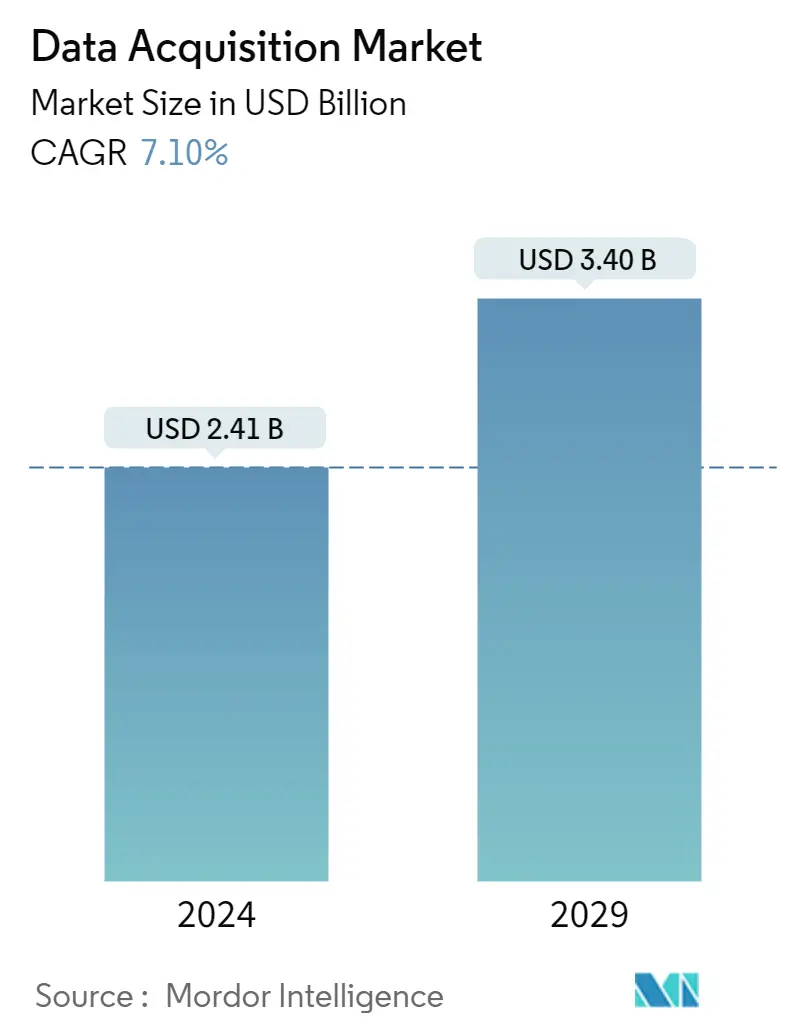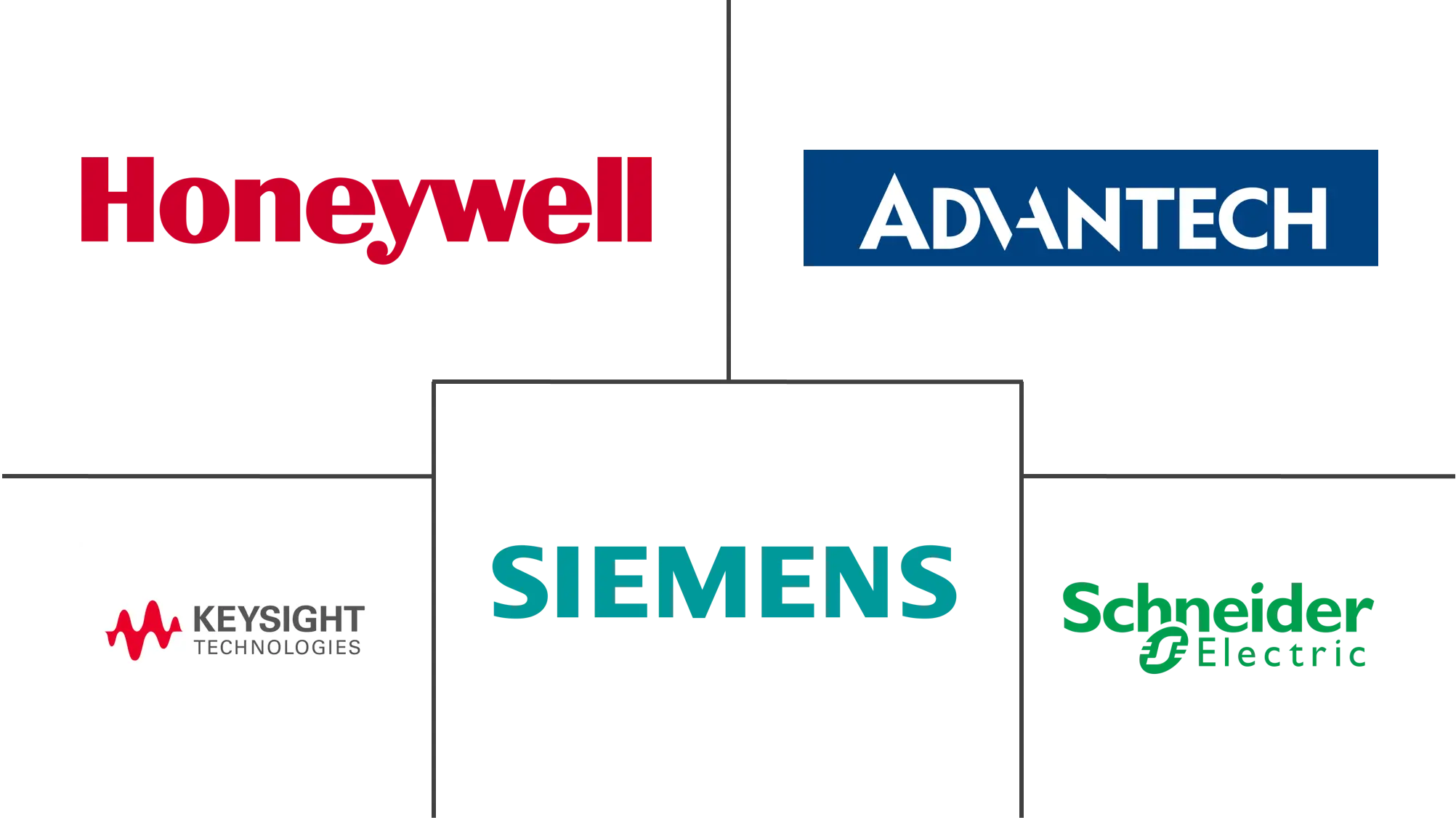Market Size of Data Acquisition Industry

| Study Period | 2019 - 2029 |
| Market Size (2024) | USD 2.41 Billion |
| Market Size (2029) | USD 3.40 Billion |
| CAGR (2024 - 2029) | 7.10 % |
| Fastest Growing Market | Asia Pacific |
| Largest Market | North America |
| Market Concentration | Low |
Major Players
*Disclaimer: Major Players sorted in no particular order |
Data Acquisition Market Analysis
The Data Acquisition Market size is estimated at USD 2.41 billion in 2024, and is expected to reach USD 3.40 billion by 2029, growing at a CAGR of 7.10% during the forecast period (2024-2029).
Data acquisition systems play an essential role in real-time decision-making in the industrial sector. As companies develop toward a data-centric approach in production and operations to maintain a competitive edge while promoting the users to access the data at any time, irrespective of the location, data acquisition systems have evolved from mere processing systems to the key to achieving the full benefits of automation.
- One of the primary drivers of the data acquisition market is the promising growth of Ethernet. Industrial Ethernet has grown faster than traditional field buses during the last few years and has overtaken field buses.
- This demand has been augmented by the growing need for faster internet speeds, seamless integration of factory installations, the adoption of IoT, and industrial controls. Such trends have been instrumental in driving the demand for data acquisition systems.
- Moreover, the adoption of factory automation and smart manufacturing across the world is a major growth driver of the data acquisition market. These include tracking multiple system parameters and monitoring many data sources while exchanging data in real-time, including PLCs, databases, maintenance applications, and existing data acquisition systems, to gain greater visibility of the machine and floor operations.
- Although North America dominated the market for data acquisition systems, good government reforms, strong industrial automation adoption, and smart manufacturing initializes are expected to boost the market in the European region to attain a more significant market share over the forecast period. This development is anticipated to be backed by the economies of Germany and the United Kingdom, which are adopting the next generation of industrial solutions.
- Additionally, advances in electronic technologies led to inexpensive sensing and monitoring capabilities. An Open-Source Hardware project called Arduino has been used, along with low-cost sensors, to develop several inexpensive, automated sensing and data logging systems for research purposes. This is suggestive of potential yet increased open-source DAQ software investment for developing the advanced system in the future.
- The pandemic forced a transition for several industries and enterprises and primed the market for a switch into fully monitored operations and the increased prescience obtained through well-designed systems. Most critical systems began implementing data acquisition systems to improve their efficacies.
Data Acquisition Industry Segmentation
Data acquisition is the process of sampling signals that measure real world physical conditions and converting the resulting samples into digital numeric values that a computer can manipulate.
The Data Acquisition Market is segmented by Channel (Less Than 32, 32-128, Greater Than 128), Type (Hardware, Software), End-User Vertical (Water and Waste Treatment, Power & Energy, Automotive, Education and Research, Aerospace & Defense, Paper and Pulp, Chemicals), and Geography.
| Channel | |
| Less than 32 | |
| 32-128 | |
| Greater than 128 |
| Type | |
| Hardware | |
| Software |
| End-User Vertical | |
| Water and Waste Treatment | |
| Power & Energy | |
| Automotive | |
| Education and Research | |
| Aerospace & Defense | |
| Paper and Pulp | |
| Chemicals | |
| Other End-Users |
| Geography | |
| North America | |
| Europe | |
| Asia Pacific | |
| Rest of the World |
Data Acquisition Market Size Summary
The industrial data acquisition systems market is poised for significant growth as it becomes increasingly integral to real-time decision-making in the industrial sector. This evolution is driven by the shift towards data-centric production and operations, which necessitates systems that can provide access to data anytime and anywhere. The market is experiencing a transformation from basic processing systems to essential components that unlock the full potential of automation. The rapid expansion of industrial Ethernet, outpacing traditional field buses, is a key factor propelling market demand. This growth is further fueled by the need for faster internet speeds, seamless factory integration, and the adoption of IoT and industrial controls. The global push towards factory automation and smart manufacturing is also a major driver, as these systems enable real-time monitoring and data exchange across various platforms, enhancing visibility and efficiency in operations.
North America currently leads the market, with significant contributions from major players like National Instruments, Keysight, and Siemens. The region's focus on intelligent manufacturing and IIoT architectures is facilitating faster production processes with minimal errors. The automotive industry, a major revenue generator in the U.S., heavily relies on efficient data acquisition to ensure compliance and operational oversight. The market is characterized by fragmentation, with key companies engaging in strategic mergers and acquisitions to enhance their capabilities. Recent developments include partnerships and product launches aimed at integrating advanced analytics and machine learning into data acquisition systems. These advancements underscore the market's trajectory towards more sophisticated and interconnected solutions, catering to the evolving needs of industries worldwide.
Data Acquisition Market Size - Table of Contents
-
1. MARKET DYNAMICS
-
1.1 Market Overview
-
1.2 Introduction to Market Drivers and Restraints
-
1.3 Market Drivers
-
1.3.1 Growing Adoption of Industrial Ethernet Solutions
-
1.3.2 Increasing Complexity in Manufacturing Establishments is Driving Operators Towards Adoption of DAQ for Design Validation and Testing
-
1.3.3 Technological Advancements Such as Edge Computing and TSN
-
-
1.4 Market Restraints
-
1.4.1 Cost Implications and Saturation in Key Markets Could Hinder Growth Over the Forecast Period
-
-
1.5 Value Chain Analysis
-
1.6 Industry Attractiveness - Porter's Five Forces Analysis
-
1.6.1 Threat of New Entrants
-
1.6.2 Bargaining Power of Buyers
-
1.6.3 Bargaining Power of Suppliers
-
1.6.4 Threat of Substitute Products
-
1.6.5 Intensity of Competitive Rivalry
-
-
1.7 Distribution Channel Analysis (Distributors, System Integrators and Direct Sales)
-
1.8 Technology Snapshot
-
1.8.1 Evolution of DAQ Connectivity Technologies
-
1.8.2 Anticipated Impact of the Adoption of TSN and Edge Computing
-
1.8.3 Analysis of the Growing Shift Towards Integrated Platforms
-
-
-
2. MARKET SEGMENTATION
-
2.1 Channel
-
2.1.1 Less than 32
-
2.1.2 32-128
-
2.1.3 Greater than 128
-
-
2.2 Type
-
2.2.1 Hardware
-
2.2.2 Software
-
-
2.3 End-User Vertical
-
2.3.1 Water and Waste Treatment
-
2.3.2 Power & Energy
-
2.3.3 Automotive
-
2.3.4 Education and Research
-
2.3.5 Aerospace & Defense
-
2.3.6 Paper and Pulp
-
2.3.7 Chemicals
-
2.3.8 Other End-Users
-
-
2.4 Geography
-
2.4.1 North America
-
2.4.2 Europe
-
2.4.3 Asia Pacific
-
2.4.4 Rest of the World
-
-
Data Acquisition Market Size FAQs
How big is the Data Acquisition Market?
The Data Acquisition Market size is expected to reach USD 2.41 billion in 2024 and grow at a CAGR of 7.10% to reach USD 3.40 billion by 2029.
What is the current Data Acquisition Market size?
In 2024, the Data Acquisition Market size is expected to reach USD 2.41 billion.

